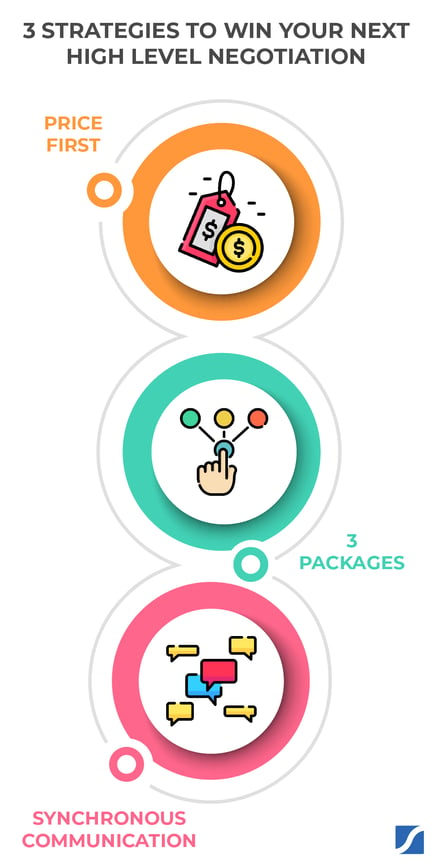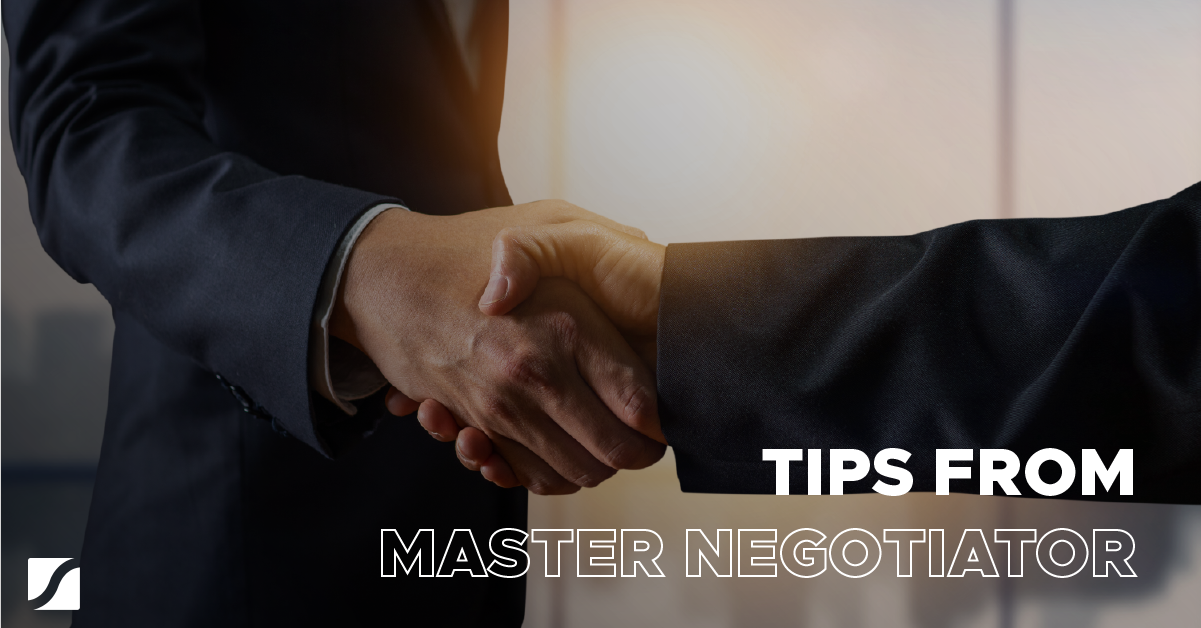3 Top Techniques To Nail Your Next High Level Negotiation

As someone who’s spent 3 decades teaching companies how to scale up, I like to think I know a thing or two about helping entrepreneurs make and save money. But when it comes to boosting profits in my own business ventures, it’s someone else’s techniques that have made the biggest difference.
The strategies of high-stakes negotiations expert Victoria Medvec have saved and made me millions. That’s because, along with hiring, negotiations are among the top 2 types of skills you need to be a strong leader and grow your business.
Done right, negotiations can help you boost profits and forge long-term business relationships. Done wrong, negotiations can result in your business leaving thousands—even millions—of dollars on the table.
Victoria is a leading global expert on negotiation strategy, corporate governance, and decision-making. In her book, Negotiate Without Fear, she shares tips to help you broker deals confidently. They’re the same pointers she’s provided not only to me but also to companies like Google, General Electric, Pfizer, EY, and BlackRock.
In this article, I'll share 3 of Victoria’s strategies that can help you win negotiations, strengthen relationships, and save millions.
3 Top Strategies For High-Stakes Negotiations
You can use Victoria Medvec’s strategies for all kinds of negotiations in your business, whether you’re looking to shorten your sales cycle or hire the best talent. Let’s explore 3 tips that can help you negotiate your way to business-growing results.
1. Price First
In these days of supply chain and inflation challenges, don’t run the risk of waking up a year from now to see your margins squeezed to the brink. Put yourself in a better position to get a price that will sustain you for years to come.
The best way to do that is by naming your price first.
By establishing this anchor, instead of waiting for the other party to do so, you have the power to set a price that provides enough wiggle room to negotiate and still come out ahead. Remember, however, that it’s just as important that the person on the other side of the table feels like a winner in the end. You’re building relationships.
Here’s an example of what I mean: A few years ago, I needed a Scaling Up chief marketing officer. I found the perfect candidate in Abby Brown. Instead of asking her to share her salary at her last job and what her salary expectations were—and running the risk of starting the negotiations with a number I couldn’t afford—I named a price first.
My offer emphasized a variety of benefits I knew were important to her and set the stage for an agreement that left us both feeling like winners. The negotiations ended with Abby joining our team.
She helped us 10x our marketing reach over the next few years.

The best way to do that is by naming your price first.
By establishing this anchor, instead of waiting for the other party to do so, you have the power to set a price that provides enough wiggle room to negotiate and still come out ahead. Remember, however, that it’s just as important that the person on the other side of the table feels like a winner in the end. You’re building relationships.
Here’s an example of what I mean: A few years ago, I needed a Scaling Up chief marketing officer. I found the perfect candidate in Abby Brown. Instead of asking her to share her salary at her last job and what her salary expectations were—and running the risk of starting the negotiations with a number I couldn’t afford—I named a price first.
My offer emphasized a variety of benefits I knew were important to her and set the stage for an agreement that left us both feeling like winners. The negotiations ended with Abby joining our team.
She helped us 10x our marketing reach over the next few years.

2. Negotiate In 3 Packages
There are a lot of ankle-biters out there. They know companies want long-term contracts that will save them the trouble and expense of constantly seeking bidders to provide products and services.
So these ankle biters offer just about any low price, hoping to simply get in the door for these longtime deals. Arm yourself against this competition—and save yourself millions of dollars—by coming to the table with 3 options for pricing: good, better, and best.
Say, for example, you have a customer taking bids for companies to provide the products they’re currently getting from you. There will be plenty of ultra-low-priced bids from competition trying to swipe this business from you.
Suggest 3 options for providing these products to the customer:
So these ankle biters offer just about any low price, hoping to simply get in the door for these longtime deals. Arm yourself against this competition—and save yourself millions of dollars—by coming to the table with 3 options for pricing: good, better, and best.
Say, for example, you have a customer taking bids for companies to provide the products they’re currently getting from you. There will be plenty of ultra-low-priced bids from competition trying to swipe this business from you.
Suggest 3 options for providing these products to the customer:
- Your “good” package should be at a price that can compete with those bargain competitors. In this offer, note the many benefits you currently provide that you’d no longer be able to offer for this low cost.
- Your “better” package offers a price you’d be comfortable accepting. It provides more benefits than the “good” package but fewer than the “best” package.
- Your “best” package should be at a price high enough that it gives you room to negotiate. This option offers a broad array of services like the ones you’re already providing to this client.
By noting the different levels of service each price includes, you’re shining a spotlight on the many extras you provide. You’re also giving the customer something to think about regarding the services they won’t get if they go with the cheap competition.
This technique has worked for corporations ranging from the large, like Dell Technologies, to the small, like a company I heard from at a recent conference. That small company fought off low-priced competitors to renew a contract with a Fortune 500 customer.
They made the deal by offering pricing packages with various levels of the services already offered. The company ultimately agreed to the “better” price that included more than the lower-priced competitor could provide.
3. Synchronous Communication
How many times have you met to negotiate with a potential customer, come to a verbal agreement, sent over a contract for finalizing later, and then … nothing? You get no response from the client, even though you left the meeting sure you had a deal.
What happened? You violated one of Victoria’s high-stakes negotiations rules.
Never simply send a contract for the client to review and get back to you.
Instead, set up a time to deliver the contract to the client and go over it line by line with them. This approach, called synchronous communication, ensures there’s someone available to discuss any concerns in real time as the client reviews the document.
Without someone on hand to address these issues, the client is likely to make those concerns the focus of their thinking about the proposed agreement. And that means those issues are likely to kill your deal.
QuEST Global is the perfect example of the value of synchronous communication in high-stakes negotiation. QuEST was bidding for the largest deal in its history, a $127 million engineering contract with Airbus Military. Its leaders left nothing to chance, booking hotel rooms across from Airbus’ headquarters so they could easily discuss their proposal and any concerns Airbus had.
When Airbus awarded QuEST the contract, it noted that QuEST had provided more contact during the negotiation process than all the other competitors combined. That availability not only landed them the contract, but it also helped forge a strong business relationship.
What happened? You violated one of Victoria’s high-stakes negotiations rules.
Never simply send a contract for the client to review and get back to you.
Instead, set up a time to deliver the contract to the client and go over it line by line with them. This approach, called synchronous communication, ensures there’s someone available to discuss any concerns in real time as the client reviews the document.
Without someone on hand to address these issues, the client is likely to make those concerns the focus of their thinking about the proposed agreement. And that means those issues are likely to kill your deal.
QuEST Global is the perfect example of the value of synchronous communication in high-stakes negotiation. QuEST was bidding for the largest deal in its history, a $127 million engineering contract with Airbus Military. Its leaders left nothing to chance, booking hotel rooms across from Airbus’ headquarters so they could easily discuss their proposal and any concerns Airbus had.
When Airbus awarded QuEST the contract, it noted that QuEST had provided more contact during the negotiation process than all the other competitors combined. That availability not only landed them the contract, but it also helped forge a strong business relationship.




